Cisco Systems 12416, 12816 User Manual 2

You'll be entered into a quarterly drawing for free Cisco Press books by returning this survey! Cisco is dedicated to customer satisfaction and would like to hear your thoughts on these printed manuals. Please visit the Cisco Product Comments on-line survey at www.cisco.com/go/crc to submit your comments about accessing Cisco technical manuals. Thank you for your time.
General Information
1 |
Years of networking experience: |
|
|
|
|
Years of experience with Cisco products: |
|
||||||||
2 |
I have these network types: |
|
LAN |
|
Backbone |
|
WAN |
||||||||
|
|
Other: |
|
|
|
|
|
|
|
|
|
|
|||
3 |
I have these Cisco products: |
|
Switches |
|
Routers |
|
|
|
|||||||
|
|
Other (specify models): |
|
|
|
|
|
|
|
|
|
|
|||
4 |
I perform these types of tasks: |
|
H/W installation and/or maintenance |
|
S/W configuration |
||||||||||
|
|
Network management |
|
Other: |
|
|
|
|
|
|
|||||
5 |
I use these types of documentation: |
|
H/W installation |
|
H/W configuration |
|
S/W configuration |
||||||||
|
|
Command reference |
|
Quick reference |
|
Release notes |
|
Online help |
|||||||
|
|
Other: |
|
|
|
|
|
|
|
|
|
|
|||
6 |
I access this information through: |
|
% Cisco.com |
|
% CD-ROM |
|
% Printed manuals |
||||||||
|
|
% Other: |
|
|
|
|
|
|
|
|
|
|
|||
7 |
I prefer this access method: |
|
Cisco.com |
|
CD-ROM |
|
Printed manuals |
||||||||
|
|
Other: |
|
|
|
|
|
|
|
|
|
|
|||
8 |
I use the following three product features the most: |
|
|
|
|
|
|||||||||
|
|
|
|
|
|
|
|
|
|
|
|
|
|
|
|
|
|
|
|
|
|
|
|
|
|
|
|
|
|
|
|
Document Information
Document Title: |
Cisco 12016, Cisco 12416, and Cisco 12816 Router Installation and Configuration Guide |
||||||
Part Number: |
OL-11495-01 |
S/W Release (if applicable): |
|
||||
On a scale of 1–5 (5 being the best), please let us know how we rate in the following areas: |
|||||||
|
The document is complete. |
|
|
The information is accurate. |
|||
|
The information is well organized. |
|
|
The information I wanted was easy to find. |
|||
|
The document is written at my |
|
|
The information I found was useful to my job. |
|||
|
technical level of understanding. |
|
|
|
|
||
Please comment on our lowest scores: |
|
|
|
|
|||
|
|
|
|
|
|
|
|
|
|
|
|
|
|
|
|
Mailing Information
Organization |
|
|
|
|
Date |
Contact Name |
|
|
|
|
|
Mailing Address |
|
|
|
|
|
City |
State/Province |
|
Zip/Postal Code |
||
Country |
Phone ( |
) |
|
Extension |
|
Fax ( |
) |
|
|
||
May we contact you further concerning our documentation? |
|
Yes |
|
|
No |
You can also send us your comments by e-mail to bug-doc@cisco.com, or by fax to 408-527-8089.
When mailing this card from outside of the United States, please enclose in an envelope addressed to the location on the back of this card with the required postage or fax to 1-408-527-8089.

NO POSTAGE
NECESSARY
IF MAILED
IN THE
UNITED STATES
BUSINESS REPLY MAIL
F I R S T - C L A S S M A I L P E R M I T N O . 4 6 3 1 S A N J O S E C A
POSTAGE WILL BE PAID BY ADDRESSEE
DOCUMENT RESOURCE CONNECTION CISCO SYSTEMS INC
170 WEST TASMAN DR SAN JOSE CA 95134-9916

Cisco 12016, Cisco 12416, and
Cisco 12816 Router Installation and
Configuration Guide
Corporate Headquarters
Cisco Systems, Inc. 170 West Tasman Drive
San Jose, CA 95134-1706 USA http://www.cisco.com Tel: 408 526-4000
800 553-NETS (6387) Fax: 408 526-4100
Text Part Number: OL-11495-01
THE SPECIFICATIONS AND INFORMATION REGARDING THE PRODUCTS IN THIS MANUAL ARE SUBJECT TO CHANGE WITHOUT NOTICE. ALL STATEMENTS, INFORMATION, AND RECOMMENDATIONS IN THIS MANUAL ARE BELIEVED TO BE ACCURATE BUT ARE PRESENTED WITHOUT WARRANTY OF ANY KIND, EXPRESS OR IMPLIED. USERS MUST TAKE FULL RESPONSIBILITY FOR THEIR APPLICATION OF ANY PRODUCTS.
THE SOFTWARE LICENSE AND LIMITED WARRANTY FOR THE ACCOMPANYING PRODUCT ARE SET FORTH IN THE INFORMATION PACKET THAT SHIPPED WITH THE PRODUCT AND ARE INCORPORATED HEREIN BY THIS REFERENCE. IF YOU ARE UNABLE TO LOCATE THE SOFTWARE LICENSE OR LIMITED WARRANTY, CONTACT YOUR CISCO REPRESENTATIVE FOR A COPY.
The following information is for FCC compliance of Class A devices: This equipment has been tested and found to comply with the limits for a Class A digital device, pursuant to part 15 of the FCC rules. These limits are designed to provide reasonable protection against harmful interference when the equipment is operated in a commercial environment. This equipment generates, uses, and can radiate radio-frequency energy and, if not installed and used in accordance with the instruction manual, may cause harmful interference to radio communications. Operation of this equipment in a residential area is likely to cause harmful interference, in which case users will be required to correct the interference at their own expense.
The following information is for FCC compliance of Class B devices: The equipment described in this manual generates and may radiate radio-frequency energy. If it is not installed in accordance with Cisco’s installation instructions, it may cause interference with radio and television reception. This equipment has been tested and found to comply with the limits for a Class B digital device in accordance with the specifications in part 15 of the FCC rules. These specifications are designed to provide reasonable protection against such interference in a residential installation. However, there is no guarantee that interference will not occur in a particular installation.
Modifying the equipment without Cisco’s written authorization may result in the equipment no longer complying with FCC requirements for Class A or Class B digital devices. In that event, your right to use the equipment may be limited by FCC regulations, and you may be required to correct any interference to radio or television communications at your own expense.
Modifications to this product not authorized by Cisco Systems, Inc. could void the FCC approval and negate your authority to operate the product.
You can determine whether your equipment is causing interference by turning it off. If the interference stops, it was probably caused by the Cisco equipment or one of its peripheral devices. If the equipment causes interference to radio or television reception, try to correct the interference by using one or more of the following measures:
•Turn the television or radio antenna until the interference stops.
•Move the equipment to one side or the other of the television or radio.
•Move the equipment farther away from the television or radio.
•Plug the equipment into an outlet that is on a different circuit from the television or radio. (That is, make certain the equipment and the television or radio are on circuits controlled by different circuit breakers or fuses.)
The Cisco implementation of TCP header compression is an adaptation of a program developed by the University of California, Berkeley (UCB) as part of UCB’s public domain version of the UNIX operating system. All rights reserved. Copyright © 1981, Regents of the University of California.
NOTWITHSTANDING ANY OTHER WARRANTY HEREIN, ALL DOCUMENT FILES AND SOFTWARE OF THESE SUPPLIERS ARE PROVIDED “AS IS” WITH ALL FAULTS. CISCO AND THE ABOVE-NAMED SUPPLIERS DISCLAIM ALL WARRANTIES, EXPRESSED OR IMPLIED, INCLUDING, WITHOUT LIMITATION, THOSE OF MERCHANTABILITY, FITNESS FOR A PARTICULAR PURPOSE AND NONINFRINGEMENT OR ARISING FROM A COURSE OF DEALING, USAGE, OR TRADE PRACTICE.
IN NO EVENT SHALL CISCO OR ITS SUPPLIERS BE LIABLE FOR ANY INDIRECT, SPECIAL, CONSEQUENTIAL, OR INCIDENTAL DAMAGES, INCLUDING, WITHOUT LIMITATION, LOST PROFITS OR LOSS OR DAMAGE TO DATA ARISING OUT OF THE USE OR INABILITY TO USE THIS MANUAL, EVEN IF CISCO OR ITS SUPPLIERS HAVE BEEN ADVISED OF THE POSSIBILITY OF SUCH DAMAGES.
CCSP, CCVP, the Cisco Square Bridge logo, Follow Me Browsing, and StackWise are trademarks of Cisco Systems, Inc.; Changing the Way We Work, Live, Play, and Learn, and iQuick Study are service marks of Cisco Systems, Inc.; and Access Registrar, Aironet, BPX, Catalyst, CCDA, CCDP, CCIE, CCIP, CCNA, CCNP, Cisco, the Cisco Certified Internetwork Expert logo, Cisco IOS, Cisco Press, Cisco Systems, Cisco Systems Capital, the Cisco Systems logo, Cisco Unity, Enterprise/Solver, EtherChannel, EtherFast, EtherSwitch, Fast Step, FormShare, GigaDrive, GigaStack, HomeLink, Internet Quotient, IOS, IP/TV, iQ Expertise, the iQ logo, iQ Net Readiness Scorecard, LightStream, Linksys, MeetingPlace, MGX, the Networkers logo, Networking Academy, Network Registrar, Packet, PIX, Post-Routing, Pre-Routing, ProConnect, RateMUX, ScriptShare, SlideCast, SMARTnet, The Fastest Way to Increase Your Internet Quotient, and TransPath are registered trademarks of Cisco Systems, Inc. and/or its affiliates in the United States and certain other countries.
All other trademarks mentioned in this document or Website are the property of their respective owners. The use of the word partner does not imply a partnership relationship between Cisco and any other company. (0601R)
Cisco 12016, Cisco 12416, and Cisco 12816 Router Installation and Configuration Guide
Copyright © 2000–2006 Cisco Systems, Inc. All rights reserved.

About This Guide
Audience
The Cisco 12016, Cisco 12416, and Cisco 12816 Router Installation and Configuration Guide is written for hardware installers and system administrators of Cisco routers.
This publication assumes that the user has a substantial background in installing and configuring router and switch-based hardware. The reader should also be familiar with electronic circuitry and wiring practices, and have experience as an electronic or electromechanical technician.
Purpose
This installation and configuration guide contains procedures for installing the router hardware, creating a basic startup configuration file, and powering on the router for the first time.
|
|
Cisco 12016, Cisco 12416, and Cisco 12816 Router Installation and Configuration Guide |
|
|
|
|
|
||
|
OL-11495-01 |
|
|
xiii |
|
|
|
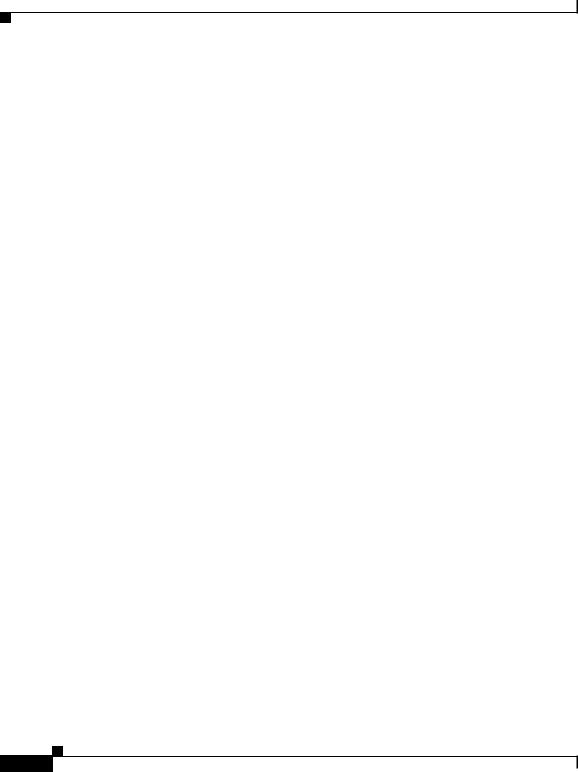
About This Guide
Document Organization
Document Organization
This installation and configuration guide is organized into the following chapters and appendixes:
•Chapter 1, “Product Overview,”provides an introduction to the major components of the Cisco 12016, Cisco 12416, and Cisco 12816 series routers.
•Chapter 2, “Preparing for Installation,” describes safety considerations, required tools and equipment, an overview of the installation, and procedures to perform before the installation.
•Chapter 3, “Installing the Router,” provides instructions for installing the hardware and connecting external network interface cables.
•Chapter 4, “System Startup and Basic Configuration,” provides simple procedures for completing a basic system configuration, and for checking and saving the configuration to system memory.
•Chapter 5, “Troubleshooting the Installation,” provides guidelines for troubleshooting the router hardware installation.
•Chapter 6, “Router Field Diagnostics,” describes how to load and run router field diagnostics.
•Chapter 7, “Maintaining the Router,”provides removal and replacement procedures for primary router components or field-replaceable units (FRUs).
•Appendix A, “Technical Specifications,” provides a summary of physical, electrical, and environmental specifications for the router.
•Appendix B, “Site Log,”provides a sample site log that can be used to record actions relevant to the operation and maintenance of the router.
•Index
|
Cisco 12016, Cisco 12416, and Cisco 12816 Router Installation and Configuration Guide |
xiv |
OL-11495-01 |
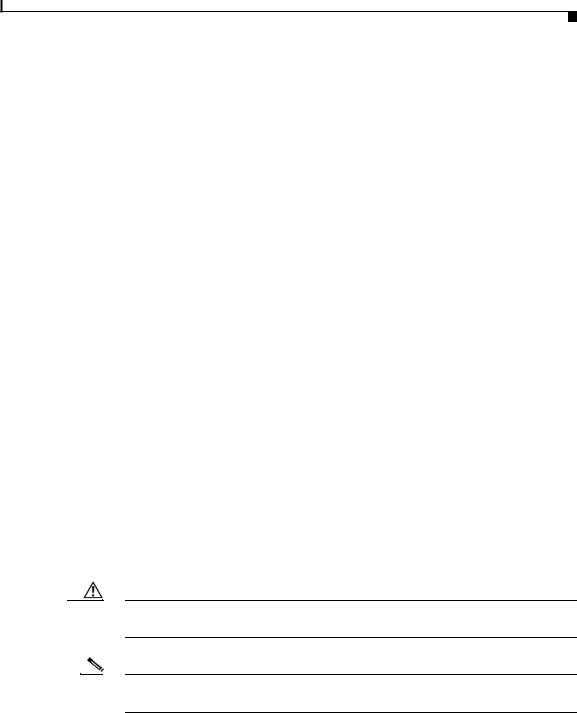
About This Guide
Document Conventions
Document Conventions
This publication uses the following conventions:
•Ctrl represents the key labeled Control. For example, the key combination Ctrl-Z means hold down the Control key while you press the z key.
Command descriptions use these conventions:
•Examples that contain system prompts denote interactive sessions, indicating the commands that you should enter at the prompt. The system prompt indicates the current level of the EXEC command interpreter.
For example, the prompt router> indicates that you should be at the user level, and the prompt router# indicates that you should be at the privileged level. Access to the privileged level usually requires a password. Refer to the related software configuration and reference documentation for additional information.
•Commands and keywords are in bold font.
•Arguments for which you supply values are in italic font.
•Elements in square brackets ([ ]) are optional.
•Alternative but required keywords are grouped in braces ({ }) and separated by vertical bars (|).
Examples use these conventions:
•Terminal sessions and sample console screen displays are in screen font.
•Information you enter is in bold font.
•Nonprinting characters, such as passwords, are in angle brackets (< >).
•Default responses to system prompts are in square brackets ([ ]).
•Exclamation points (!) at the beginning of a line indicate a comment line.
Caution Means reader be careful. You are capable of doing something that might result in equipment damage or loss of data.
Note Means reader take note. Notes contain helpful suggestions or references to materials not contained in this manual.
|
|
Cisco 12016, Cisco 12416, and Cisco 12816 Router Installation and Configuration Guide |
|
|
|
|
|
||
|
OL-11495-01 |
|
|
xv |
|
|
|
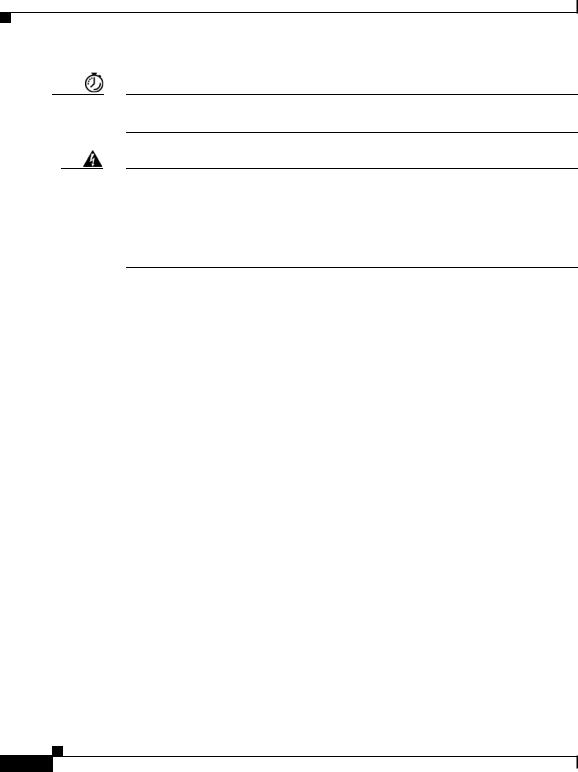
About This Guide
Obtaining Documentation
Timesaver Means the described action saves time. You can save time by performing the action described in the paragraph.
Warning This warning symbol means danger. You are in a situation that could cause bodily injury. Before you work on any equipment, be aware of the hazards involved with electrical circuitry and be familiar with standard practices for preventing accidents. To see translations of the warnings that appear in this publication, refer to the Regulatory Compliance and Safety Information document that accompanied this device.
Obtaining Documentation
Cisco documentation and additional literature are available on Cisco.com. Cisco also provides several ways to obtain technical assistance and other technical resources. These sections explain how to obtain technical information from Cisco Systems.
Cisco.com
You can access the most current Cisco documentation at this URL:
http://www.cisco.com/techsupport
You can access the Cisco website at this URL:
http://www.cisco.com
You can access international Cisco websites at this URL:
http://www.cisco.com/public/countries_languages.shtml
|
Cisco 12016, Cisco 12416, and Cisco 12816 Router Installation and Configuration Guide |
xvi |
OL-11495-01 |

About This Guide
Obtaining Documentation
Product Documentation DVD
Cisco documentation and additional literature are available in the Product Documentation DVD package, which may have shipped with your product. The Product Documentation DVD is updated regularly and may be more current than printed documentation.
The Product Documentation DVD is a comprehensive library of technical product documentation on portable media. The DVD enables you to access multiple versions of hardware and software installation, configuration, and command guides for Cisco products and to view technical documentation in HTML. With the DVD, you have access to the same documentation that is found on the Cisco website without being connected to the Internet. Certain products also have .pdf versions of the documentation available.
The Product Documentation DVD is available as a single unit or as a subscription. Registered Cisco.com users (Cisco direct customers) can order a Product Documentation DVD (product number DOC-DOCDVD=) from the Ordering tool or Cisco Marketplace.
Cisco Ordering tool:
http://www.cisco.com/en/US/partner/ordering/
Cisco Marketplace:
http://www.cisco.com/go/marketplace/
Ordering Documentation
Beginning June 30, 2005, registered Cisco.com users may order Cisco documentation at the Product Documentation Store in the Cisco Marketplace at this URL:
http://www.cisco.com/go/marketplace/
Cisco will continue to support documentation orders using the Ordering tool:
•Registered Cisco.com users (Cisco direct customers) can order documentation from the Ordering tool:
http://www.cisco.com/en/US/partner/ordering/
|
|
Cisco 12016, Cisco 12416, and Cisco 12816 Router Installation and Configuration Guide |
|
|
|
|
|
||
|
OL-11495-01 |
|
|
xvii |
|
|
|
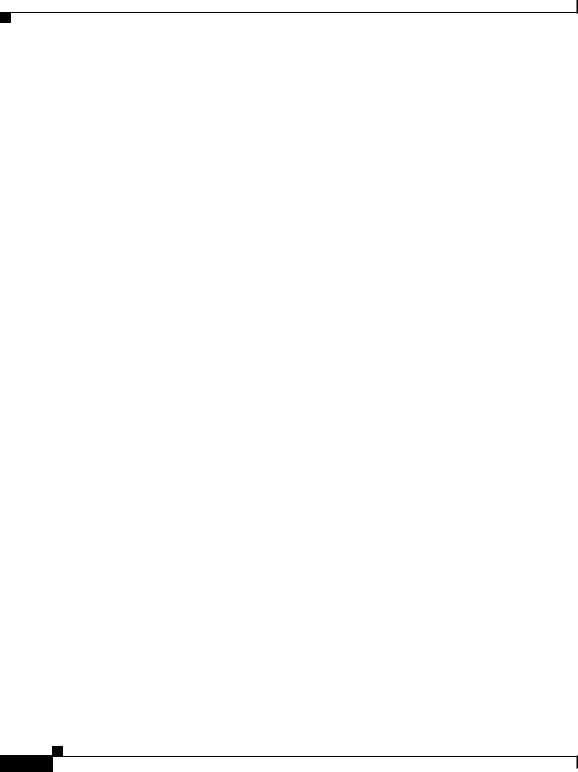
About This Guide
Documentation Feedback
•Instructions for ordering documentation using the Ordering tool are at this URL:
http://www.cisco.com/univercd/cc/td/doc/es_inpck/pdi.htm
•Nonregistered Cisco.com users can order documentation through a local account representative by calling Cisco Systems Corporate Headquarters (California, USA) at 408 526-7208 or, elsewhere in North America, by calling 1 800 553-NETS (6387).
Documentation Feedback
You can rate and provide feedback about Cisco technical documents by completing the online feedback form that appears with the technical documents on Cisco.com.
You can send comments about Cisco documentation to bug-doc@cisco.com.
You can submit comments by using the response card (if present) behind the front cover of your document or by writing to the following address:
Cisco Systems
Attn: Customer Document Ordering
170 West Tasman Drive
San Jose, CA 95134-9883
We appreciate your comments.
Cisco Product Security Overview
Cisco provides a free online Security Vulnerability Policy portal at this URL:
http://www.cisco.com/en/US/products/products_security_vulnerability_policy.ht ml
From this site, you can perform these tasks:
•Report security vulnerabilities in Cisco products.
•Obtain assistance with security incidents that involve Cisco products.
•Register to receive security information from Cisco.
|
Cisco 12016, Cisco 12416, and Cisco 12816 Router Installation and Configuration Guide |
xviii |
OL-11495-01 |
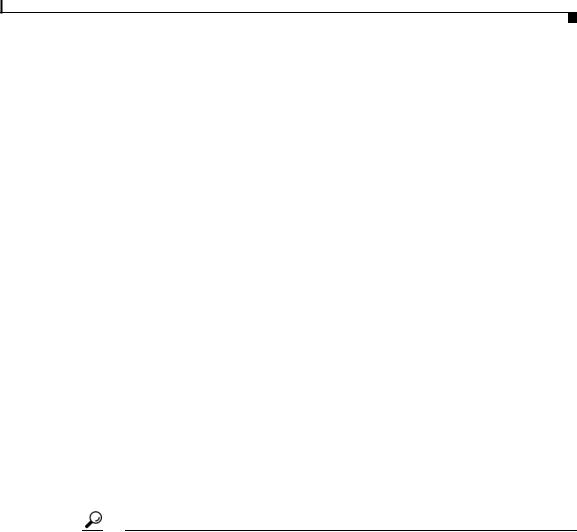
About This Guide
Cisco Product Security Overview
A current list of security advisories and notices for Cisco products is available at this URL:
http://www.cisco.com/go/psirt
If you prefer to see advisories and notices as they are updated in real time, you can access a Product Security Incident Response Team Really Simple Syndication (PSIRT RSS) feed from this URL:
http://www.cisco.com/en/US/products/products_psirt_rss_feed.html
Reporting Security Problems in Cisco Products
Cisco is committed to delivering secure products. We test our products internally before we release them, and we strive to correct all vulnerabilities quickly. If you think that you might have identified a vulnerability in a Cisco product, contact PSIRT:
•Emergencies — security-alert@cisco.com
An emergency is either a condition in which a system is under active attack or a condition for which a severe and urgent security vulnerability should be reported. All other conditions are considered nonemergencies.
•Nonemergencies — psirt@cisco.com
In an emergency, you can also reach PSIRT by telephone:
•1 877 228-7302
•1 408 525-6532
Tip We encourage you to use Pretty Good Privacy (PGP) or a compatible product to encrypt any sensitive information that you send to Cisco. PSIRT can work from encrypted information that is compatible with PGP versions 2.x through 8.x.
Never use a revoked or an expired encryption key. The correct public key to use in your correspondence with PSIRT is the one linked in the Contact Summary section of the Security Vulnerability Policy page at this URL:
http://www.cisco.com/en/US/products/products_security_vulnerability_policy.ht ml
|
|
Cisco 12016, Cisco 12416, and Cisco 12816 Router Installation and Configuration Guide |
|
|
|
|
|
||
|
OL-11495-01 |
|
|
xix |
|
|
|
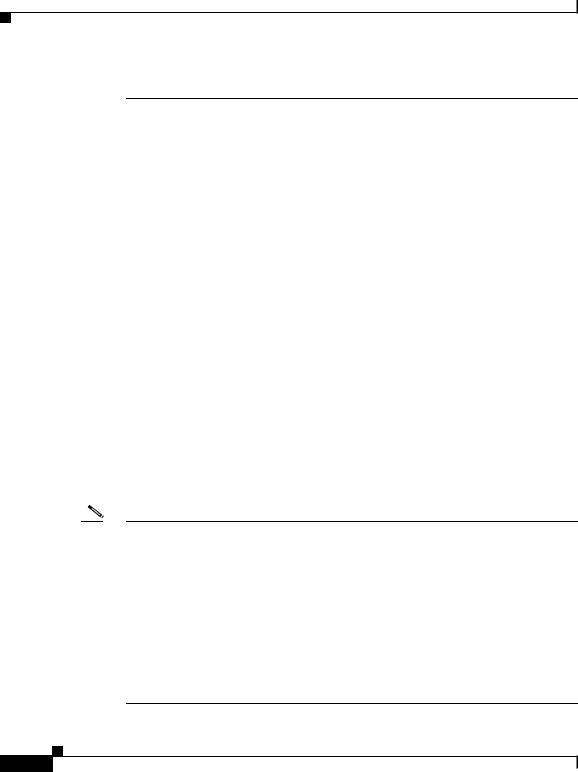
About This Guide
Obtaining Technical Assistance
The link on this page has the current PGP key ID in use.
Obtaining Technical Assistance
Cisco Technical Support provides 24-hour-a-day award-winning technical assistance. The Cisco Technical Support & Documentation website on Cisco.com features extensive online support resources. In addition, if you have a valid Cisco service contract, Cisco Technical Assistance Center (TAC) engineers provide telephone support. If you do not have a valid Cisco service contract, contact your reseller.
Cisco Technical Support & Documentation Website
The Cisco Technical Support & Documentation website provides online documents and tools for troubleshooting and resolving technical issues with Cisco products and technologies. The website is available 24 hours a day, at this URL:
http://www.cisco.com/techsupport
Access to all tools on the Cisco Technical Support & Documentation website requires a Cisco.com user ID and password. If you have a valid service contract but do not have a user ID or password, you can register at this URL:
http://tools.cisco.com/RPF/register/register.do
Note Use the Cisco Product Identification (CPI) tool to locate your product serial number before submitting a web or phone request for service. You can access the CPI tool from the Cisco Technical Support & Documentation website by clicking the Tools & Resources link under Documentation & Tools. Choose Cisco Product Identification Tool from the Alphabetical Index drop-down list, or click the Cisco Product Identification Tool link under Alerts & RMAs. The CPI tool offers three search options: by product ID or model name; by tree view; or for certain products, by copying and pasting show command output. Search results show an illustration of your product with the serial number label location highlighted. Locate the serial number label on your product and record the information before placing a service call.
|
Cisco 12016, Cisco 12416, and Cisco 12816 Router Installation and Configuration Guide |
xx |
OL-11495-01 |

About This Guide
Obtaining Technical Assistance
Submitting a Service Request
Using the online TAC Service Request Tool is the fastest way to open S3 and S4 service requests. (S3 and S4 service requests are those in which your network is minimally impaired or for which you require product information.) After you describe your situation, the TAC Service Request Tool provides recommended solutions. If your issue is not resolved using the recommended resources, your service request is assigned to a Cisco engineer. The TAC Service Request Tool is located at this URL:
http://www.cisco.com/techsupport/servicerequest
For S1 or S2 service requests or if you do not have Internet access, contact the Cisco TAC by telephone. (S1 or S2 service requests are those in which your production network is down or severely degraded.) Cisco engineers are assigned immediately to S1 and S2 service requests to help keep your business operations running smoothly.
To open a service request by telephone, use one of the following numbers:
Asia-Pacific: +61 2 8446 7411 (Australia: 1 800 805 227)
EMEA: +32 2 704 55 55
USA: 1 800 553-2447
For a complete list of Cisco TAC contacts, go to this URL:
http://www.cisco.com/techsupport/contacts
Definitions of Service Request Severity
To ensure that all service requests are reported in a standard format, Cisco has established severity definitions.
Severity 1 (S1)—Your network is “down,” or there is a critical impact to your business operations. You and Cisco will commit all necessary resources around the clock to resolve the situation.
Severity 2 (S2)—Operation of an existing network is severely degraded, or significant aspects of your business operation are negatively affected by inadequate performance of Cisco products. You and Cisco will commit full-time resources during normal business hours to resolve the situation.
|
|
Cisco 12016, Cisco 12416, and Cisco 12816 Router Installation and Configuration Guide |
|
|
|
|
|
||
|
OL-11495-01 |
|
|
xxi |
|
|
|
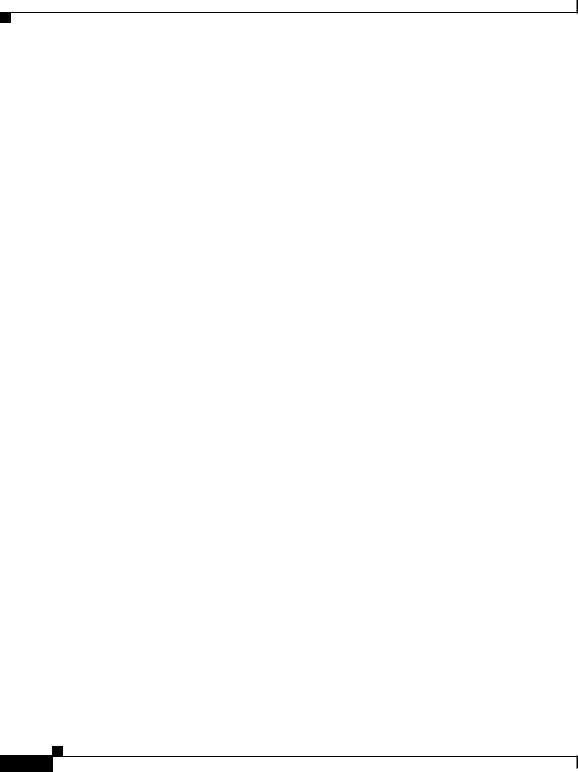
About This Guide
Obtaining Additional Publications and Information
Severity 3 (S3)—Operational performance of your network is impaired, but most business operations remain functional. You and Cisco will commit resources during normal business hours to restore service to satisfactory levels.
Severity 4 (S4)—You require information or assistance with Cisco product capabilities, installation, or configuration. There is little or no effect on your business operations.
Obtaining Additional Publications and Information
Information about Cisco products, technologies, and network solutions is available from various online and printed sources.
•Cisco Marketplace provides a variety of Cisco books, reference guides, documentation, and logo merchandise. Visit Cisco Marketplace, the company store, at this URL:
http://www.cisco.com/go/marketplace/
•Cisco Press publishes a wide range of general networking, training and certification titles. Both new and experienced users will benefit from these publications. For current Cisco Press titles and other information, go to Cisco Press at this URL:
http://www.ciscopress.com
•Packet magazine is the Cisco Systems technical user magazine for maximizing Internet and networking investments. Each quarter, Packet delivers coverage of the latest industry trends, technology breakthroughs, and Cisco products and solutions, as well as network deployment and troubleshooting tips, configuration examples, customer case studies, certification and training information, and links to scores of in-depth online resources. You can access Packet magazine at this URL:
http://www.cisco.com/packet
•iQ Magazine is the quarterly publication from Cisco Systems designed to help growing companies learn how they can use technology to increase revenue, streamline their business, and expand services. The publication identifies the challenges facing these companies and the technologies to help
|
Cisco 12016, Cisco 12416, and Cisco 12816 Router Installation and Configuration Guide |
xxii |
OL-11495-01 |

About This Guide
Obtaining Additional Publications and Information
solve them, using real-world case studies and business strategies to help readers make sound technology investment decisions. You can access iQ Magazine at this URL:
http://www.cisco.com/go/iqmagazine
or view the digital edition at this URL:
http://ciscoiq.texterity.com/ciscoiq/sample/
•Internet Protocol Journal is a quarterly journal published by Cisco Systems for engineering professionals involved in designing, developing, and operating public and private internets and intranets. You can access the Internet Protocol Journal at this URL:
http://www.cisco.com/ipj
•Networking products offered by Cisco Systems, as well as customer support services, can be obtained at this URL:
http://www.cisco.com/en/US/products/index.html
•Networking Professionals Connection is an interactive website for networking professionals to share questions, suggestions, and information about networking products and technologies with Cisco experts and other networking professionals. Join a discussion at this URL:
http://www.cisco.com/discuss/networking
•World-class networking training is available from Cisco. You can view current offerings at this URL:
http://www.cisco.com/en/US/learning/index.html
|
|
Cisco 12016, Cisco 12416, and Cisco 12816 Router Installation and Configuration Guide |
|
|
|
|
|
||
|
OL-11495-01 |
|
|
xxiii |
|
|
|
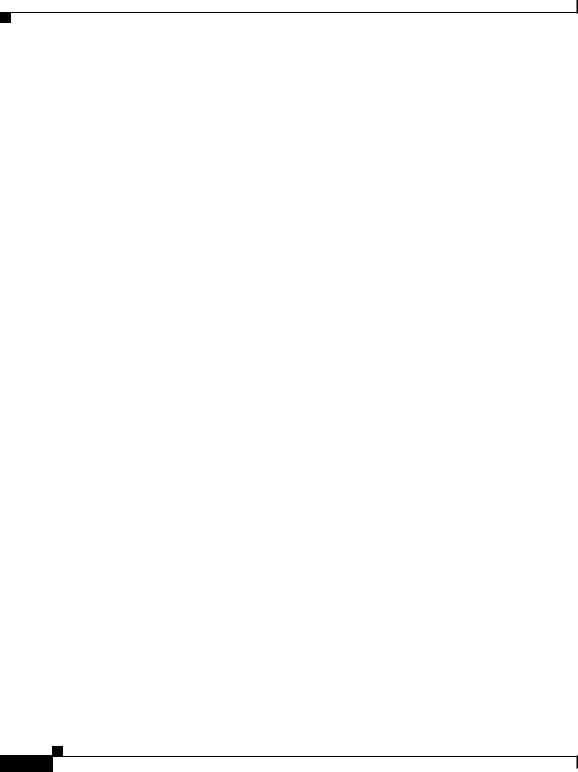
About This Guide
Obtaining Additional Publications and Information
|
Cisco 12016, Cisco 12416, and Cisco 12816 Router Installation and Configuration Guide |
xxiv |
OL-11495-01 |

C O N T E N T S
|
|
About This Guide xiii |
|
|
|
|
|
|
|
|
|
|
|
Audience |
xiii |
|
|
|
|
|
|
|
|
|
|
Purpose |
xiii |
|
|
|
|
|
|
|
|
|
|
Document Organization |
xiv |
|
|
|
|
|
|
||
|
|
Document Conventions |
xv |
|
|
|
|
|
|
|
|
|
|
Obtaining Documentation |
xvi |
|
|
|
|
|
|
||
|
|
Cisco.com xvi |
|
|
|
|
|
|
|
|
|
|
|
Product Documentation DVD |
|
xvii |
|
|
|
|
|||
|
|
Ordering Documentation xvii |
|
|
|
|
|
||||
|
|
Documentation Feedback |
xviii |
|
|
|
|
|
|
||
|
|
Cisco Product Security Overview |
xviii |
|
|
|
|
||||
|
|
Reporting Security Problems in Cisco Products |
xix |
||||||||
|
|
Obtaining Technical Assistance |
xx |
|
|
|
|
||||
|
|
Cisco Technical Support & Documentation Website xx |
|||||||||
|
|
Submitting a Service Request |
xxi |
|
|
|
|
||||
|
|
Definitions of Service Request Severity |
xxi |
|
|
|
|||||
|
|
Obtaining Additional Publications and Information |
xxii |
||||||||
|
Product Overview 1-1 |
|
|
|
|
|
|
|
|
||
C H A P T E R 1 |
|
|
|
|
|
|
|
|
|||
|
|
Introduction 1-1 |
|
|
|
|
|
|
|
|
|
|
|
Physical and Functional Description of Router |
1-2 |
|
|
|
|||||
|
|
AC and DC Power Subsystems |
1-4 |
|
|
|
|
||||
|
|
Standard AC Power Shelf |
1-4 |
|
|
|
|
||||
|
|
Optional AC Power Shelf |
1-7 |
|
|
|
|
||||
|
|
Cisco 12016, Cisco 12416, and Cisco 12816 Router Installation and Configuration Guide |
|
|
|||||||
|
|
|
|||||||||
|
OL-11495-01 |
|
|
|
|
|
|
|
|
|
iii |
|
|
|
|
|
|
|
|
|
|
||

Contents
|
|
AC Power Supplies |
1-10 |
|
|
|
||
|
|
DC Power Shelf 1-12 |
|
|
|
|||
|
|
DC Power Supplies |
1-15 |
|
|
|
||
|
|
Chassis Card Cages 1-17 |
|
|
|
|
||
|
|
Upper Card Cage |
1-17 |
|
|
|
|
|
|
|
Lower Card Cage |
1-18 |
|
|
|
|
|
|
|
Switch Fabric Card Cage |
1-18 |
|
|
|
||
|
|
Switch Fabric Overview 1-19 |
|
|
|
|
||
|
|
Switch Fabric Card Functionality 1-19 |
|
|
|
|||
|
|
Clock Scheduler Cards 1-20 |
|
|
|
|||
|
|
Switch Fabric Cards |
1-20 |
|
|
|
||
|
|
Alarm Card, Line Card, and Rout Processor Overview 1-21 |
||||||
|
|
Alarm Cards |
1-21 |
|
|
|
|
|
|
|
Line Cards |
1-23 |
|
|
|
|
|
|
|
Route Processor Selection 1-24 |
|
|
|
|||
|
|
Gigabit Route Processor Overview 1-24 |
|
|
|
|||
|
|
GRP PCMCIA Card Slots and Status LEDs |
1-25 |
|
||||
|
|
GRP Reset Switch 1-27 |
|
|
|
|||
|
|
GRP Auxiliary and Console Ports 1-28 |
|
|
||||
|
|
GRP Ethernet Ports and Status LEDs |
1-28 |
|
|
|||
|
|
GRP Alphanumeric Message Displays 1-30 |
||||||
|
|
GRP Memory Components 1-31 |
|
|
|
|||
|
|
GRP DRAM |
1-33 |
|
|
|
|
|
|
|
GRP SRAM |
1-33 |
|
|
|
|
|
|
|
GRP NVRAM |
1-33 |
|
|
|
|
|
|
|
GRP Flash Memory |
1-34 |
|
|
|
||
|
|
Performance Route Processor Overview |
1-34 |
|
|
|||
|
|
PRP PCMCIA Card Slots and Status LEDs |
1-35 |
|
||||
|
|
PRP Ethernet Ports and Status LEDs |
1-35 |
|
|
|||
|
|
PRP Auxiliary and Console Ports 1-36 |
|
|
||||
|
|
Cisco 12016, Cisco 12416, and Cisco 12816 Router Installation and Configuration Guide |
||||||
|
|
|||||||
iv |
|
|
|
|
|
|
OL-11495-01 |
|
|
|
|
|
|
|
|
||

Contents
|
PRP Reset Switch |
1-37 |
|
||
|
PRP Alphanumeric Message Displays |
1-38 |
|||
|
PRP Memory Components |
1-39 |
|
||
|
PRP SDRAM |
1-41 |
|
|
|
|
PRP SRAM |
1-41 |
|
|
|
|
PRP NVRAM |
1-42 |
|
|
|
|
PRP Flash Memory |
1-42 |
|
||
|
Upper and Lower Cable Management Brackets 1-43 |
||||
|
Blower Module 1-44 |
|
|
|
|
|
Preparing for Installation 2-1 |
|
|
|
|
C H A P T E R 2 |
|
|
|
||
|
Safety Guidelines 2-2 |
|
|
|
|
|
Safety with Equipment |
2-2 |
|
||
|
Safety with Electricity |
2-3 |
|
|
|
|
Preventing Electrostatic Discharge Damage |
2-4 |
|||
|
Lifting Guidelines 2-6 |
|
|
|
|
|
Compliance and Safety Information 2-6 |
|
|||
|
Laser Safety 2-7 |
|
|
|
|
|
Site Requirement Guidelines 2-7 |
|
|||
|
Rack-Mounting Guidelines |
2-7 |
|
||
|
Enclosed Rack 2-8 |
|
|
|
|
|
Open Rack 2-8 |
|
|
|
|
|
Telco Rack |
2-9 |
|
|
|
|
Site Layout and Equipment Dimensions |
2-11 |
|||
|
Air Flow Guidelines 2-15 |
|
|
||
|
Temperature and Humidity Guidelines 2-17 |
|
|||
|
Power Connection Guidelines 2-17 |
|
|||
|
AC-Powered Routers |
2-18 |
|
||
|
DC-Powered Routers |
2-19 |
|
||
|
NEBS Supplemental Unit Bonding and Grounding Guidelines |
2-22 |
|
|
|
Cisco 12016, Cisco 12416, and Cisco 12816 Router Installation and Configuration Guide |
|
|
|
|
||||
|
OL-11495-01 |
|
|
v |
|
|
|
||
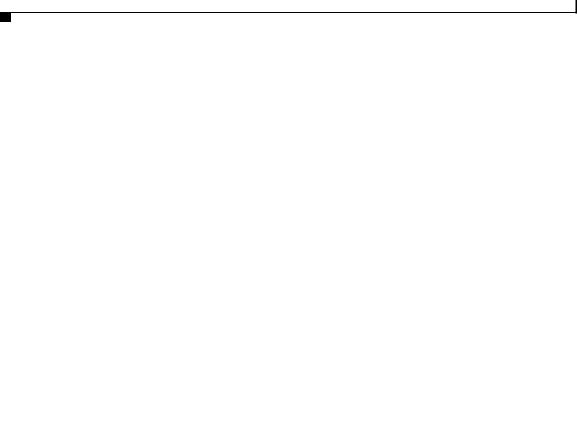
Contents
|
|
|
|
Site Wiring Guidelines 2-24 |
|
|
|
|
|
|
|
|
|
|
|
|
GRP Port Connection Guidelines |
2-25 |
|
|
|
|
|
|
|
|
|
|
|
GRP Auxiliary and Console Port Connections |
2-26 |
|
|
|||||
|
|
|
|
GRP Auxiliary Port Signals |
2-27 |
|
|
|
|
|
|
|
|
|
|
|
GRP Console Port Signals |
2-28 |
|
|
|
|
|
|
|
|
|
|
|
GRP Ethernet Port Connections |
2-29 |
|
|
|
|
|
|
|
|
|
|
|
GRP RJ-45 Ethernet Connections |
2-31 |
|
|
|
|
|||
|
|
|
|
GRP MII Ethernet Connections |
2-33 |
|
|
|
|
|||
|
|
|
|
PRP Port Connection Guidelines |
2-36 |
|
|
|
|
|
|
|
|
|
|
|
PRP Auxiliary and Console Port Connection Guidelines 2-36 |
|
|
||||||
|
|
|
|
PRP Auxiliary Port Signals |
2-38 |
|
|
|
|
|
|
|
|
|
|
|
PRP Console Port Signals |
2-39 |
|
|
|
|
|
|
|
|
|
|
|
PRP Ethernet Connections |
2-40 |
|
|
|
|
|
|
|
|
|
|
|
PRP RJ-45 Ethernet Connections |
2-42 |
|
|
|
|
|||
|
|
|
|
Alarm Card Connection Guidelines |
2-45 |
|
|
|
|
|
|
|
|
|
Installing the Router 3-1 |
|
|
|
|
|
|
|
|
||
C H A P T E R 3 |
|
|
|
|
|
|
|
|
|
|||
|
|
|
|
Pre-Installation Considerations and Requirements |
|
3-2 |
|
|
||||
|
|
|
|
Required Tools and Equipment |
3-3 |
|
|
|
|
|
|
|
|
|
|
|
Unpacking and Positioning the Router |
3-3 |
|
|
|
|
|||
|
|
|
|
Removing the Front Covers from Cisco 12016 Original Series Routers |
3-4 |
|
||||||
|
|
|
|
Removing the Front Cover from Cisco 12016 Enhanced Series Routers |
3-6 |
|
||||||
|
|
|
|
Rack-Mounting the Router Chassis |
3-8 |
|
|
|
|
|
|
|
|
|
|
|
Verifying Rack Dimensions |
3-8 |
|
|
|
|
|
|
|
|
|
|
|
Installing Center-Mount Brackets—Optional |
3-9 |
|
|
|||||
|
|
|
|
Installing the Chassis Rack-Mounting Platform |
3-13 |
|
|
|||||
|
|
|
|
Unpack and Position the Router |
3-15 |
|
|
|
|
|
||
|
|
|
|
Installing the Chassis into the Rack |
3-16 |
|
|
|
|
|||
|
|
|
|
Supplemental Bonding and Grounding Connections |
3-21 |
|
|
|||||
|
|
|
Cisco 12016, Cisco 12416, and Cisco 12816 Router Installation and Configuration Guide |
|
|
|||||||
|
|
|
|
|
||||||||
vi |
|
|
|
|
|
|
|
|
|
OL-11495-01 |
|
|
|
|
|
|
|
|
|
|
|
|
|||
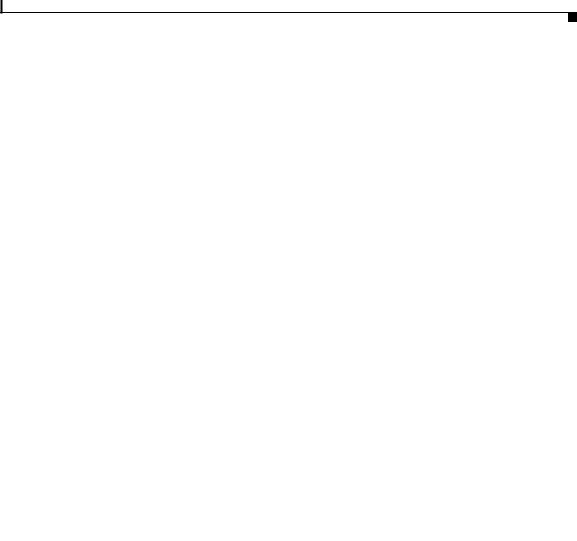
Contents
Connecting to the Front Grounding Receptacle |
3-22 |
|
Connecting to the Top Rear Receptacle 3-24 |
|
|
Attaching the Vertical Cable-Management Trough |
3-25 |
|
Connecting Line Card Network Interface Cables 3-27 |
||
Connecting GRP Route Processor Cables |
3-31 |
|
Connecting to the GRP Console Port |
3-32 |
|
Connecting to the GRP Auxiliary Port |
3-33 |
|
Connecting to the GRP Ethernet Port |
3-33 |
|
RJ-45 Connection 3-35 |
|
|
MII Connection 3-35 |
|
|
Connecting PRP Route Processor Cables |
3-36 |
|
Connecting to the PRP Console Port |
3-37 |
|
Connecting to the PRP Auxiliary Port |
3-38 |
|
Connecting to the PRP Ethernet Ports |
3-38 |
|
|
|
Connecting an Alarm Card Cable 3-40 |
|
|
|
|
|
|
|
Connecting Power to the Power Shelf 3-41 |
|
|
|
|
|
|
|
Connecting Power to the AC-Input Power Shelf |
3-41 |
|
|
|
|
|
|
Connecting Power to the DC-Input Power Shelf |
3-42 |
|
|
|
|
|
|
Installing the Front Covers of Cisco 12016 Original Series Routers |
3-47 |
|
|||
|
|
Installing the Front Cover of Cisco 12010 Enhanced Series Routers |
3-49 |
||||
|
System Startup and Basic Configuration 4-1 |
|
|
|
|
||
C H A P T E R 4 |
|
|
|
|
|||
|
|
Sources of Cisco IOS Software |
4-2 |
|
|
|
|
|
|
Preconfiguration Requirements |
4-2 |
|
|
|
|
|
|
Boot Process Overview 4-3 |
|
|
|
|
|
|
|
Powering On the Router and Observing the Boot Process 4-4 |
|
|
|
||
|
|
Manually Booting the System |
4-11 |
|
|
|
|
|
|
Locating a Valid Cisco IOS Software Image 4-12 |
|
|
|
|
|
|
|
Cisco 12016, Cisco 12416, and Cisco 12816 Router Installation and Configuration Guide |
|
|
|
||
|
|
|
|
|
|||
|
OL-11495-01 |
|
|
|
|
|
vii |
|
|
|
|
|
|
||

Contents
|
|
Booting from the Cisco IOS Software Image |
4-12 |
|
|
|
|
|
|
Configuring the Router |
4-14 |
|
|
|
|
|
|
Cisco IOS User Interface 4-15 |
|
|
|
|
|
|
|
Cisco IOS User Interface Command Modes 4-15 |
|
|
|
||
|
|
User EXEC Mode 4-16 |
|
|
|
|
|
|
|
Privileged EXEC Mode 4-16 |
|
|
|
|
|
|
|
Global Configuration Mode 4-17 |
|
|
|
|
|
|
|
Using Setup for Configuration Changes 4-18 |
|
|
|
|
|
|
|
Configuring Global Parameters Using the Setup Facility |
4-22 |
|
|||
|
|
Configuring Network Interfaces 4-24 |
|
|
|
|
|
|
|
Checking the Software Version Number and Installed Interfaces 4-26 |
|||||
|
|
Using Global Configuration Mode 4-27 |
|
|
|
|
|
|
|
Verifying Running Configuration File Settings |
4-28 |
|
|
|
|
|
|
Saving the Running Configuration Settings to NVRAM |
4-29 |
|
|
||
|
|
Viewing the Running Configuration Settings |
4-30 |
|
|
|
|
|
|
Configuring the Software Configuration Register |
4-31 |
|
|
|
|
|
|
Setting Software Configuration Settings 4-33 |
|
|
|
||
|
|
Changing Software Configuration Register Settings 4-35 |
|
|
|||
|
|
Low-Order Bits in the Software Configuration Register |
4-37 |
|
|
||
|
|
High-Order Bits in the Software Configuration Register |
4-39 |
|
|
||
|
|
Recovering a Lost Password 4-41 |
|
|
|
|
|
|
|
Using RP Flash Memory Cards 4-44 |
|
|
|
|
|
|
|
Installing and Removing a Flash Memory Card 4-44 |
|
|
|
||
|
|
Formatting a New Flash Memory Card 4-47 |
|
|
|
|
|
|
|
Specifying a Cisco IOS Software Image to Boot the System |
4-48 |
|
|||
|
|
Flash Memory Commands 4-49 |
|
|
|
|
|
|
|
pwd Command 4-49 |
|
|
|
|
|
|
|
cd Command |
4-49 |
|
|
|
|
|
|
dir Command |
4-50 |
|
|
|
|
|
|
delete Command 4-50 |
|
|
|
|
|
|
|
Cisco 12016, Cisco 12416, and Cisco 12816 Router Installation and Configuration Guide |
|
|
|
||
|
|
|
|
|
|||
viii |
|
|
|
|
|
OL-11495-01 |
|
|
|
|
|
|
|
||
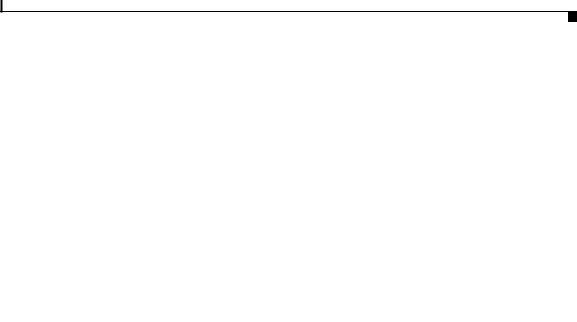
Contents
|
squeeze Command 4-51 |
|
|
Booting from Flash Memory 4-52 |
|
|
Copying Image Files to or From Flash Memory |
4-52 |
|
Copying a Cisco IOS Software Image into a Flash Memory Card 4-54 |
|
|
Copying Cisco IOS Software Images Between Flash Memory Cards 4-56 |
|
|
Copying System Configuration Files Between RP Memory and a Flash |
|
|
Memory Card 4-57 |
|
|
Booting a New Cisco IOS Software Image from a Flash Memory |
|
|
Card 4-62 |
|
|
Recovering from Locked Blocks in Flash Memory Cards 4-62 |
|
|
Post-Installation Procedures 4-63 |
|
|
Troubleshooting the Installation 5-1 |
|
C H A P T E R 5 |
|
|
|
Troubleshooting Overview 5-2 |
|
|
Troubleshooting Using a Subsystem Approach |
5-2 |
|
Normal Router Startup Sequence 5-3 |
|
|
Identifying Startup Issues 5-4 |
|
|
Troubleshooting the Power Subsystem 5-5 |
|
|
|
|
|
|
Troubleshooting the AC-Input Power Subsystem |
5-6 |
|
|
|
|
|
Troubleshooting the DC-Input Power Subsystem |
5-10 |
|
|
|
|
|
Additional Power Subsystem Troubleshooting Information |
5-14 |
||||
|
Troubleshooting the Power Distribution System |
5-15 |
|
|
|
|
|
Troubleshooting the Processor Subsystem 5-17 |
|
|
|
|
|
|
Troubleshooting the RP 5-18 |
|
|
|
|
|
|
Troubleshooting Using the RP Alphanumeric Display |
5-19 |
|
|
|
|
|
Troubleshooting Line Cards 5-20 |
|
|
|
|
|
|
Troubleshooting Using the Line Card Alphanumeric Display |
5-22 |
||||
|
Troubleshooting Using the Alarm Cards 5-27 |
|
|
|
|
|
|
Monitoring Critical, Major, and Minor Alarm Status |
5-28 |
|
|
|
|
|
Troubleshooting the Switch Fabric 5-29 |
|
|
|
|
|
|
Cisco 12016, Cisco 12416, and Cisco 12816 Router Installation and Configuration Guide |
|
|
|
||
|
|
|
||||
|
OL-11495-01 |
|
|
|
|
ix |
|
|
|
|
|
||

Contents
|
|
|
|
Analyzing the Data |
5-30 |
|
|
|
|
|
|
|
|
|
|
|
crc16 Output |
5-30 |
|
|
|
|
|
|
|
|
|
|
|
Grant Parity and Request Errors |
5-33 |
|
||||||
|
|
|
|
Properly Seating Switch Fabric Cards |
|
5-35 |
|
|||||
|
|
|
|
Troubleshooting the Cooling Subsystem |
5-36 |
|
||||||
|
|
|
|
Blower Module Operation |
5-38 |
|
|
|
|
|||
|
|
|
|
Power Supply Operation |
5-38 |
|
|
|
|
|||
|
|
|
|
Overtemperature Conditions |
5-39 |
|
|
|
|
|||
|
|
|
|
Isolating Cooling Subsystem Problems |
5-39 |
|
||||||
|
|
|
Router Field Diagnostics |
|
|
|
|
|
|
|
||
C H A P T E R |
6 |
|
6-1 |
|
|
|
|
|
|
|||
|
|
|
|
Diagnostics Overview |
6-2 |
|
|
|
|
|
|
|
|
|
|
|
Downloading the Diagnostic Image |
6-3 |
|
||||||
|
|
|
|
Field-Programmable Gate Array Overview |
|
6-3 |
|
|||||
|
|
|
|
Upgrading an FPGA Image on a Line Card 6-5 |
||||||||
|
|
|
|
Using the diag Command |
6-8 |
|
|
|
|
|
|
|
|
|
|
|
Diagnostic Commands for Cisco 12016, Cisco 12416, and Cisco 12816 |
||||||||
|
|
|
|
RouterLine Cards |
6-8 |
|
|
|
|
|
|
|
|
|
|
|
Diagnostic Commands for Cisco 12000 Series Rout Processors 6-9 |
||||||||
|
|
|
|
Diagnostic Commands for Cisco 12000 Series Switch Fabric Cards and Clock |
||||||||
|
|
|
|
Scheduler Cards 6-9 |
|
|
|
|
|
|
||
|
|
|
|
Diagnostic Command Reference Table |
6-9 |
|
||||||
|
|
|
|
diag Command Output Examples |
6-13 |
|
|
|
|
|||
|
|
|
|
Testing Without the verbose Option |
6-13 |
|
||||||
|
|
|
|
Testing Using the verbose Option |
6-14 |
|
||||||
|
|
|
|
Displaying Previous Test Results |
6-16 |
|
|
|||||
|
|
|
Maintaining the Router |
|
|
|
|
|
|
|
||
C H A P T E R |
7 |
|
7-1 |
|
|
|
|
|
|
|||
|
|
|
|
Prerequisites and Preparation |
7-2 |
|
|
|
|
|||
|
|
|
|
Powering Off the Router |
7-2 |
|
|
|
|
|
|
|
|
|
|
Cisco 12016, Cisco 12416, and Cisco 12816 Router Installation and Configuration Guide |
|||||||||
|
|
|
||||||||||
x |
|
|
|
|
|
|
|
|
|
|
OL-11495-01 |
|
|
|
|
|
|
|
|
|
|
|
|
||

Contents
Removing and Installing the Front Covers and Bezel Extenders on Original Cisco 12000 Series Routers 7-3
Removing the Front Covers 7-3
Installing the Front Covers 7-4
Attaching Bezel Extenders to the Front Cover 7-6
Removing and Replacing the Air Filter Door Front Cover 7-9
Removing and Installing Front Doors on Cisco 12016 Enhanced Series
Routers 7-13
Cleaning or Replacing the Chassis Air Filter 7-17
Cleaning or Replacing the Chassis Air Filter on Cisco 12016 Original Series
Routers 7-18
Cleaning or Replacing the Chassis Air Filter on Cisco 12016 Enhanced Series
Routers 7-22
|
Removing and Replacing Blower Modules 7-24 |
|
|
|
|
|
Upper and Lower Blower Module Orientation 7-25 |
|
|
||
|
Troubleshooting the Blower Installation 7-28 |
|
|
|
|
|
Removing and Replacing AC and DC Power Subsystem Components |
7-29 |
|||
|
Installation Guidelines 7-29 |
|
|
|
|
|
Power Supply and Power Shelf Compatibility 7-30 |
|
|
||
|
Installing Upgrade Kits 7-32 |
|
|
|
|
|
Removing and Replacing an AC Power Supply 7-33 |
|
|
|
|
|
Troubleshooting the AC Power Supply Installation |
7-42 |
|
|
|
|
Removing and Replacing the Standard AC-Input Power Shelf 7-44 |
|
|
||
|
Removing and Replacing the Optional 2-Level AC-Input Power Shelf |
7-51 |
|||
|
Troubleshooting the AC Power Shelf Installation |
7-57 |
|
|
|
|
Upgrading the AC-Input Power Shelf |
7-59 |
|
|
|
|
Removing and Replacing a DC PEM |
7-60 |
|
|
|
|
Troubleshooting the DC PEM Installation 7-66 |
|
|
|
|
|
Removing and Replacing the DC-Input Power Shelf 7-68 |
|
|
||
|
Troubleshooting the DC Power Shelf Installation |
7-77 |
|
|
|
|
Cisco 12016, Cisco 12416, and Cisco 12816 Router Installation and Configuration Guide |
|
|
||
|
|
||||
|
OL-11495-01 |
|
|
|
xi |
|
|
|
|
||
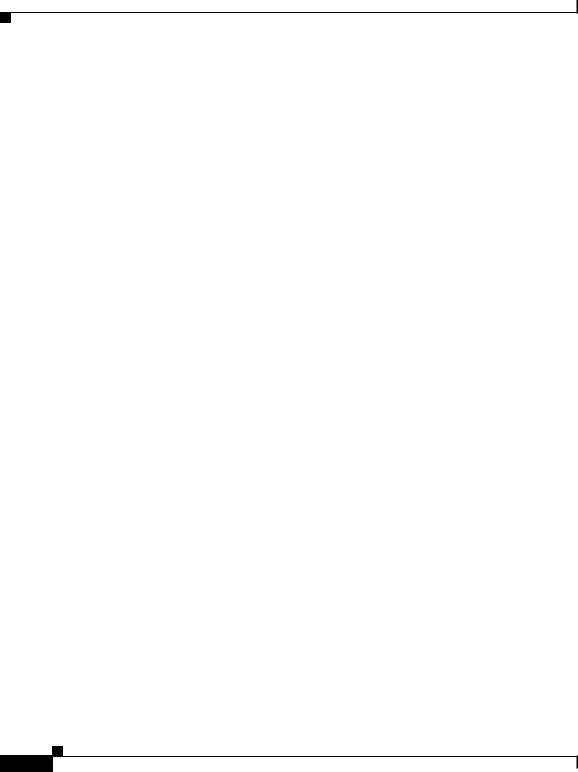
Contents
Removing and Replacing Cards from the Chassis |
7-79 |
|
Removing and Replacing RP and Line Cards from the Upper and Lower Card |
||
Cages 7-79 |
|
|
Removing and Replacing an Alarm Card 7-81 |
|
|
Removing and Replacing Switch Fabric Cards |
7-84 |
|
Upgrading the Switch Fabric |
7-86 |
|
Upgrade Requirements |
7-86 |
|
Upgrade Procedures 7-87 |
|
|
|
|
Removing and Installing a Chassis |
7-88 |
|
|
|
|
Preparing the Replacement Chassis |
7-90 |
|
|
|
|
Preparing the Installed Chassis for Removal |
7-90 |
||
|
|
Removing and Installing System Components |
7-91 |
||
|
|
Removing the Chassis from the Equipment Rack 7-92 |
|||
|
|
Installing the Replacement Chassis |
7-97 |
|
|
|
|
Removing and Replacing a Power Bus Board Fuse |
7-97 |
||
|
|
Technical Specifications A-1 |
|
|
|
A P P E N D I X |
A |
|
|
|
|
|
|
Router Specifications A-1 |
|
|
|
|
|
Compliance and Safety Information |
A-5 |
|
|
|
|
Site Log B-1 |
|
|
|
A P P E N D I X |
B |
|
|
|
|
|
|
|
|
|
|
I N D E X |
|
|
|
|
|
|
Cisco 12016, Cisco 12416, and Cisco 12816 Router Installation and Configuration Guide |
xii |
OL-11495-01 |

C H A P T E R 1
Product Overview
This chapter provides an overview of the Cisco 12016, Cisco 12416, and Cisco 12816 series routers. It contains physical descriptions of the router hardware and major components, as well as functional descriptions of the hardware-related features.
Introduction
The routers described in this guide are part of the Cisco 12016, Cisco 12416, and Cisco 12816 series routers and include:
•The original Cisco 12016, Cisco 12416, and Cisco 12816 series routers.
•The newer Cisco 12016, Cisco 12416, and Cisco 12816 enhanced series routers. The enhanced series of routers use higher capacity power supplies, more powerful blower modules, and have newly designed front doors.
The capacity of the router switch fabric differentiates each model:
•Cisco 12016 Router—2.5-Gbps switch fabric
•Cisco 12416 Route—10-Gbps switch fabric
•Cisco 12816 Router—40-Gbps switch fabric
Other than their various capacities, these routers are nearly identical. Differences between each router are described where necessary, and unless otherwise noted, the information in this publication applies to all routers.
|
|
Cisco 12016, Cisco 12416, and Cisco 12816 Router Installation and Configuration Guide |
|
|
|
|
|
||
|
OL-11495-01 |
|
|
1-1 |
|
|
|
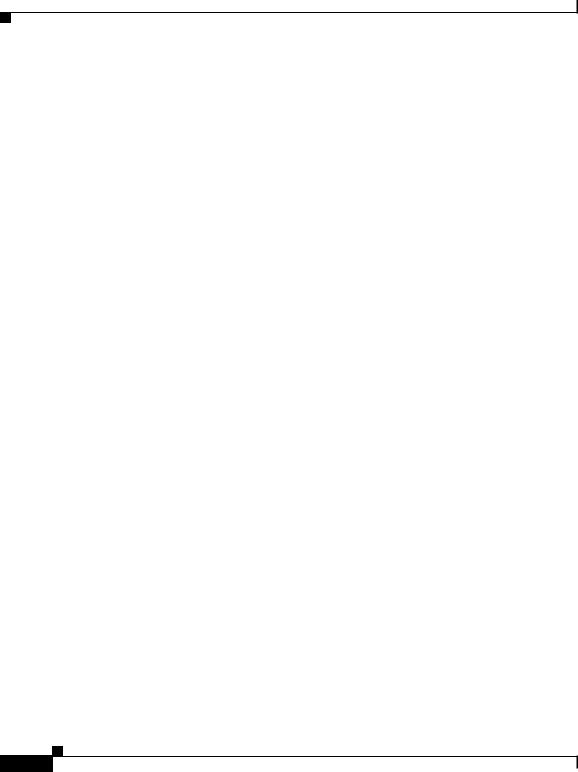
Chapter 1 Product Overview
Physical and Functional Description of Router
Physical and Functional Description of Router
The Cisco 12000 series router chassis is a sheet-metal enclosure that houses router components. The major components consist of three power supplies, upper and lower line card cages, a switch fabric card cage, and upper and lower blower modules. Power is distributed to these components over the chassis backplane.
All router models contain the following major components (Figure 1-1):
•Power shelf and power supplies—Three AC or DC power entry modules (PEMs) provide power to the router. See the “AC and DC Power Subsystems” section on page 1-4 for additional information.
•Upper blower module—Supplies cooling air to the upper half of the router so it does not overheat. See the “Blower Module” section on page 1-44 for additional information.
•Upper and lower cable management brackets—Used to neatly route line card cables. See the “Upper and Lower Cable Management Brackets” section on page 1-43 for additional information.
•Upper Line card and Route Processor card cage—Has 8 user-configurable slots that support a combination of line cards, a route processor (RP), and an alarm card. See the “Alarm Card, Line Card, and Rout Processor Overview” section on page 1-21 for additional information.
•Switch fabric card cage—Located behind the air filter door, this card cage contains 5 slots for the switch fabric card set. The switch fabric card set is made up of 3 switch fabric cards (SFCs) and 2 clock scheduler cards (CSCs). See the “Switch Fabric Overview” section on page 1-19 for additional information.
•Lower Line card and Route Processor card cage—Has 8 user-configurable slots that support a combination of line cards, a redundant route processor (RP), and an alarm card. See the “Alarm Card, Line Card, and Rout Processor Overview” section on page 1-21 for additional information.
•Lower blower module—Supplies cooling air to the lower half of the router so it does not overheat. See the “Blower Module” section on page 1-44 for additional information.
•Chassis backplane (not shown)—Distributes power to card cages and to the blower modules.
|
Cisco 12016, Cisco 12416, and Cisco 12816 Router Installation and Configuration Guide |
1-2 |
OL-11495-01 |
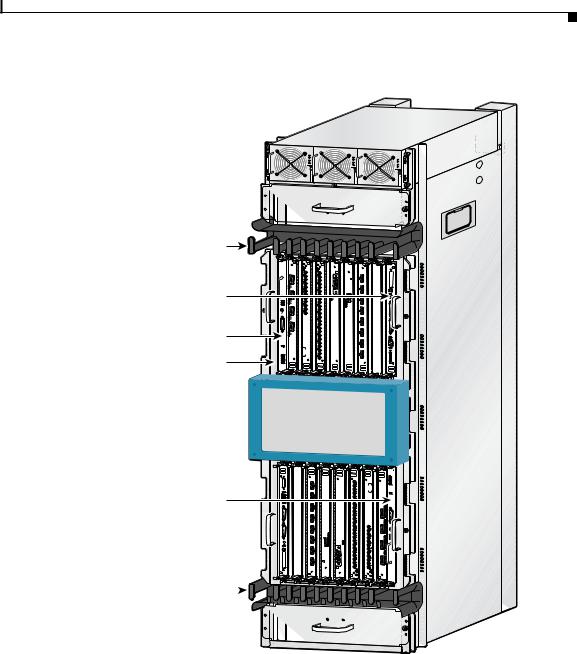
Chapter 1 Product Overview
Physical and Functional Description of Router
Figure 1-1 Cisco 12016 Series Router Components—Front View
Power shelf and  power supplies
power supplies 

Upper blower 
 module
module
Upper cable |
|
|
|
management |
|
|
|
bracket |
0 |
0 |
|
|
1 |
1 |
|
RP |
2 |
2 |
|
3 |
3 |
AUX |
|
|
4 |
4 |
|
|
5 |
5 |
|
|
|
|
CON |
|
|
|
SOLE |
|
|
6 |
|
Alarm card |
|
7 |
|
|
9 |
|
|
|
|
8 |
|
|
|
10 |
|
Upper card cage |
|
11 |
|
|
|
FAST |
|
|
/ / |
/ / |
ETERNET |
Air filter door 
Switch fabric  card cage
card cage
(behind filter door)
Alarm card
Lower card cage 
Lower cable management bracket 
LESO ONC
AUX
ETERNET |
/ / |
/ / |
FAST |
|
|
|
11 |
|
|
10 |
|
|
9 |
|
|
8 |
|
|
7 |
|
|
6 |
|
|
5 |
5 |
|
4 |
4 |
|
3 |
3 |
|
2 |
2 |
|
1 |
1 |
|
0 |
0 |
Lower blower 
 module
module
26194
|
|
Cisco 12016, Cisco 12416, and Cisco 12816 Router Installation and Configuration Guide |
|
|
|
|
|
||
|
OL-11495-01 |
|
|
1-3 |
|
|
|
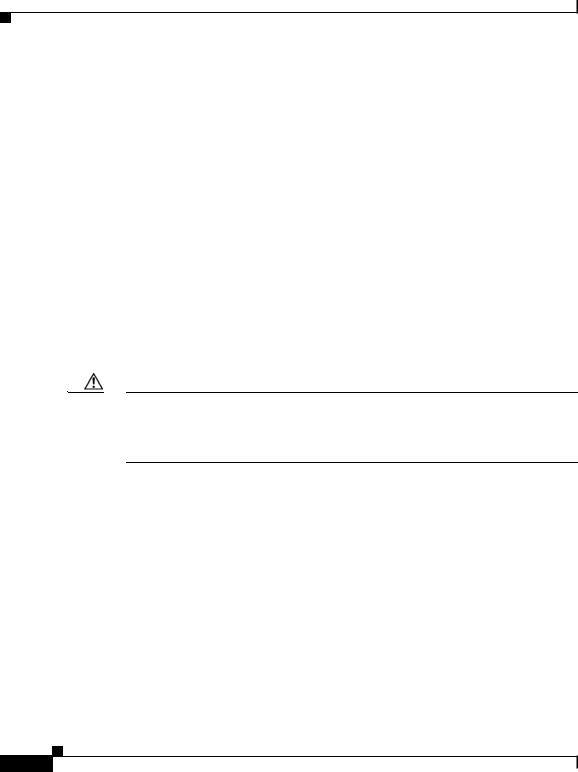
Chapter 1 Product Overview
Physical and Functional Description of Router
AC and DC Power Subsystems
A router ships with either an AC or DC powered system. Source power connects to the power shelf at the back of the chassis which route power to the power supplies, also referred to as power entry modules (PEMs).
Standard AC Power Shelf
The standard AC-input power subsystem consists of a single-level AC-input power shelf that house three (2000 W original series or 2400 W enhanced series) AC power supplies which supply full redundant power to the router. Figure 1-2 shows the standard power shelf housing original series 2000 W power supplies.
The power supplies participate in an N+1 redundant current-sharing scheme that is divided among all three power supplies. If one power supply fails, the system can continue to operate temporarily, (depending on your system configuration) with the remaining two power supplies. Failed power supplies should be replaced as soon as possible to ensure full redundancy.
Caution To ensure that the chassis configuration complies with the required power budgets, use the on-line power calculator. Failure to properly verify the configuration may result in an unpredictable state if one of the power units fails. Contact your local sales representative for assistance.
|
Cisco 12016, Cisco 12416, and Cisco 12816 Router Installation and Configuration Guide |
1-4 |
OL-11495-01 |
